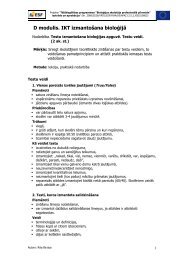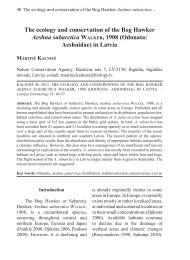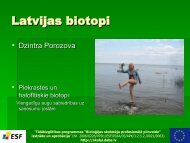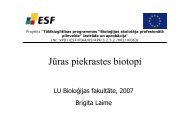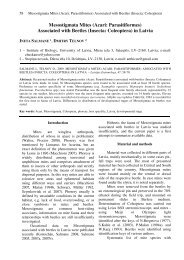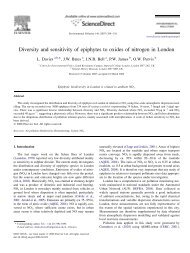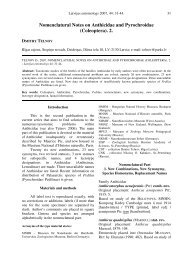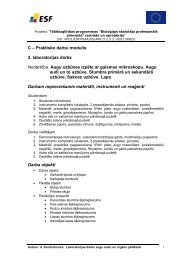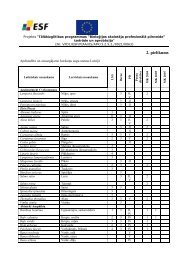Dissolved organic matter in water of Daugava river
Dissolved organic matter in water of Daugava river
Dissolved organic matter in water of Daugava river
Create successful ePaper yourself
Turn your PDF publications into a flip-book with our unique Google optimized e-Paper software.
Efficiency <strong>of</strong> energy transfer,%Efficiency <strong>of</strong> energy transfer,%Interaction <strong>of</strong> Fibrillar Insul<strong>in</strong> and Glob<strong>in</strong> with Liposomes: ResonanceEnergy Transfer StudyM.Romanova *1 , I.Maliyov 1 , A.Kastorna 1 , K.Vus 1 , V.Trusova 1 , J.Molotkovsky 2 , G.Gorbenko 11 V.N. Karaz<strong>in</strong> Kharkov National University, Kharkov, Ukra<strong>in</strong>e;2 Institute <strong>of</strong> Bio<strong>organic</strong> Chemistry, Russian Academy <strong>of</strong> Sciences, Moscow, Russiae-mail: romanova-mari@mail.ruA wide range <strong>of</strong> prote<strong>in</strong>s are capable <strong>of</strong> assembl<strong>in</strong>g <strong>in</strong>to cross β-sheet structures (amyloidfibrils) under pathological or nonphysiological conditions. The toxicity <strong>of</strong> amyloid fibrilsand their precursors is supposed to be associated with their action on structural andfunctional state <strong>of</strong> biological membranes. One way <strong>of</strong> approach<strong>in</strong>g this problem is basedon the use <strong>of</strong> model systems consist<strong>in</strong>g <strong>of</strong> lipid vesicles and prote<strong>in</strong> aggregates formed <strong>in</strong>vitro.The present study was directed towards clarify<strong>in</strong>g the molecular details <strong>of</strong> <strong>in</strong>teractionbetween glob<strong>in</strong> or <strong>in</strong>sul<strong>in</strong> fibrils and liposomes <strong>of</strong> different composition. Fibrillaraggregates were obta<strong>in</strong>ed by prote<strong>in</strong> <strong>in</strong>cubation <strong>in</strong> glyc<strong>in</strong>e buffer (pH 2.2) at 60 o C dur<strong>in</strong>g8 days. To assess the extent <strong>of</strong> fibril b<strong>in</strong>d<strong>in</strong>g to liposomes, we measured energy transferefficiency from tryptophan residues <strong>of</strong> glob<strong>in</strong> or <strong>in</strong>sul<strong>in</strong> to anthrylv<strong>in</strong>yl (AV) fluorophorecovalently attached to phosphatidylchol<strong>in</strong>e (PC). Lipid vesicles were prepared from PCand its mixtures with anionic lipid phosphatidylser<strong>in</strong>e (PS) (10, 20, 40 mol% PS).Increas<strong>in</strong>g the concentration <strong>of</strong> glob<strong>in</strong> fibrils resulted <strong>in</strong> the raise <strong>of</strong> AV fluorescence<strong>in</strong>tensity for all model systems under study (Fig.1). It was found that the most effectiveenergy transfer occurs when glob<strong>in</strong> <strong>in</strong>teracts with neutral PC vesicles. In the case <strong>of</strong><strong>in</strong>sul<strong>in</strong>, conversely, the energy transfer from Trp to AV-PC was negligible. Thisobservation can be expla<strong>in</strong>ed by the fact that <strong>in</strong>sul<strong>in</strong> has negative charge under theemployed experimental conditions (pH 7.4), which prevents prote<strong>in</strong> b<strong>in</strong>d<strong>in</strong>g to negativelycharged PC/PS liposomes.4.03.5PCPS10PS20PS404,03,53.03,02.52,52.02,01.51.00.50.00 2 4 6 8 10 12Concentration <strong>of</strong> Glob<strong>in</strong>, M1,51,00,50,0Insul<strong>in</strong>Glob<strong>in</strong>Fig.1. Efficiency <strong>of</strong> energy transfer as afunction <strong>of</strong> fibrillar glob<strong>in</strong> concentrationFig.2. Comparison <strong>of</strong> energy transfer fromTrp to AV-PC for <strong>in</strong>sul<strong>in</strong> and glob<strong>in</strong>Fig.2 illustrates the difference between fibrillar <strong>in</strong>sul<strong>in</strong> and glob<strong>in</strong> <strong>in</strong> the energy transferefficiency from Trp to AV-PC <strong>in</strong> PC bilayers. The results obta<strong>in</strong>ed allowed us to supposethat the character <strong>of</strong> <strong>in</strong>teraction between glob<strong>in</strong> fibrils and liposomes is mostlyhydrophobic, while <strong>in</strong> the case <strong>of</strong> <strong>in</strong>sul<strong>in</strong> the role <strong>of</strong> electrostatics may be predom<strong>in</strong>ant.This work was supported by the grant from Fundamental Research State Fund <strong>of</strong> Ukra<strong>in</strong>e(project number F.41.4/014).- 30 -



